The Chelemeras Maya Women Restoring Mangroves in Mexico’s Yucatán

A group of Maya women, the Chelemeras, are restoring mangrove forests in Mexico’s Yucatán Peninsula, safeguarding biodiversity, and protecting their communities from climate change impacts.
The mangrove forests of Mexico’s Yucatán Peninsula serve as vital bridges between the sea and the land, essential in stabilizing shorelines, storing carbon, and providing shelter for diverse wildlife. These unique ecosystems support local livelihoods by offering a habitat for endangered species like the hawksbill turtle and fostering the reproduction of crabs and fish. On land, the mangroves’ exposed roots and trapped sediment provide pathways for monkeys, tapirs, and jaguars, while their branches offer nesting sites for flamingos, ibises, and rare songbirds. Coral reefs flourish, and crocodiles find refuge in the shadows of these coastal forests.
Despite their ecological importance, many mangrove forests are threatened by urban sprawl. The destruction of these natural barriers leaves communities vulnerable to storm surges and undermines the significant carbon sequestration that mangroves provide—four times more per square meter than tropical rainforests. Amid these challenges, a dedicated group of Maya women near Chelem, 32 miles north of Mérida, are making a difference.
The Chelemeras: Pioneering Women in Grassroots Restoration Efforts
In 2010, a government-funded project sought volunteers to restore mangroves in Chelem. A group of local Maya women, the Chelemeras, answered the call. Even after the funding was cut two years later, the women persisted, driven by their commitment to their community and the environment. Their unwavering resilience in the face of adversity is truly inspiring. Over the years, they have successfully restored more than 50 hectares of mangrove forest, equivalent to about 71 soccer fields.
The Chelemeras’ efforts have not gone unnoticed. Their work has garnered international acclaim from organizations such as UNESCO and the Blue Marine Foundation. Their restoration model is now seen as an exemplary approach to community-led environmental conservation in the region. By planting and nurturing mangrove saplings, the Chelemeras have strengthened coastal defenses, improved local fisheries, and created habitats for wildlife, thus preserving biodiversity and supporting sustainable livelihoods.
Biodiversity and Community Resilience
Mangroves are critical to the biodiversity of the Yucatán Peninsula. Their dense root systems provide nursery grounds for many marine species, including fish and crustaceans, essential for local fisheries. Birds like flamingos and ibises depend on the mangroves for nesting, while larger animals such as jaguars and tapirs use them as corridors to move through the landscape safely.
The Chelemeras understand the intricate balance between mangroves and the well-being of their community. By restoring these forests, they are not only protecting wildlife but also enhancing their community’s resilience against climate change. Their work acts as a shield, protecting the community from the increasing threat of extreme weather events that are becoming more frequent with global warming, instilling a sense of security and care.
Additionally, mangroves play a crucial role in carbon sequestration. They capture and store significant amounts of carbon dioxide, helping mitigate the effects of climate change. By expanding mangrove coverage, the Chelemeras contribute to global efforts to combat climate change. Their work is a beacon of hope in the face of the daunting challenge of climate change, securing their region’s ecological and economic future and instilling a sense of optimism in the audience.
International Recognition and Future Challenges
The Chelemeras’ Success: A Global Inspiration the Chelemeras’ success has not gone unnoticed. Their work has been celebrated by prestigious organizations such as UNESCO and the Blue Marine Foundation, underscoring the importance of community-led conservation initiatives. These accolades have brought global attention to the critical role of women in environmental stewardship and the potential of grassroots movements to effect significant change.
Challenges on the Horizon Despite their success, the Chelemeras continue to face challenges. The threat of urban development looms over the remaining mangrove forests, and the pressure to convert these areas into residential and commercial zones is increasing as cities expand. The Chelemeras are committed to advocating for the protection of these vital ecosystems while continuing their restoration efforts.
Sustainable funding and resources are also needed to support their work. While international recognition has helped raise awareness, consistent financial and logistical support is crucial for the long-term success of their projects. Partnerships with governmental and non-governmental organizations can provide the necessary backing to scale up their efforts and ensure the mangroves are protected for future generations. Your support can make a difference.
A Model for Latin America
The story of the Chelemeras offers valuable lessons for other communities in Latin America and beyond. Their perseverance and dedication demonstrate the power of grassroots movements in driving environmental conservation. Conservation projects can be more effective and sustainable by involving local communities in restoration efforts.
Similar initiatives can be implemented to protect and restore critical ecosystems in many parts of Latin America. The success of the Chelemeras highlights the importance of community engagement, local knowledge, and women’s active participation in environmental conservation. These elements are vital to building resilient communities and preserving biodiversity in the face of global environmental challenges.
The Chelemeras’Chelemeras model can inspire other regions to adopt community-driven approaches to conservation. By fostering a sense of ownership and responsibility among local populations, conservation efforts can achieve greater impact and sustainability. Collaboration between local communities, governments, and international organizations is essential for addressing Latin America’s complex environmental issues.
The Chelemeras of Chelem exemplify the powerful impact of community-led conservation efforts. Their work restoring mangrove forests on Mexico’s Yucatán Peninsula protects vital ecosystems and enhances community resilience to climate change. Their story is a testament to the dedication and perseverance of local women in safeguarding their environment and heritage.
As urbanization and climate change continue to threaten natural landscapes, the efforts of groups like the Chelemeras become increasingly important. Their success underscores the need for sustained support and collaboration to protect and restore ecosystems worldwide. By learning from their example, other communities can adopt similar approaches to address environmental challenges.
Alos read: Hurricane Beryl Threatens Mexico’s Quintana Roo With Severe Impact
The Chelemeras’ achievements remind us that meaningful change often begins at the grassroots level. Their tireless work shows that it can significantly impact the fight against climate change and biodiversity loss. Their story is a beacon of hope and inspiration for all committed to protecting our planet’s natural resources for future generations.





